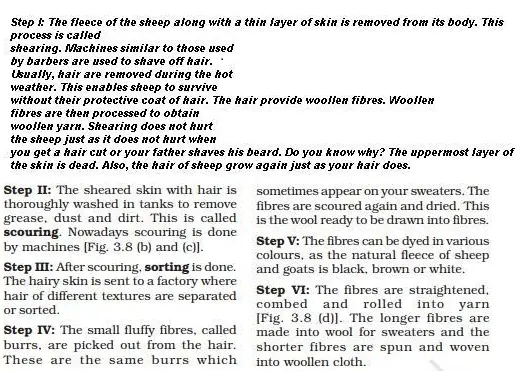Very Short Type Questions Solution:
(1) Ans:- Two fibres obtained from animals are wool and silk.
(2) Ans:- Yak wool is common in the hilly regions of Tibet and Ladakh.
(3) Ans:- Angora goats found in Jammu & Kashmir.
(4) Ans:- Kashmiri goat.
(5) Ans:- Llama and Alpaca are found at South America.
(6) Ans:- The two breeds of sheep found in India are Lohi and Rampur bushair.
(7) Ans:- Sheep are herbivores.
(8) Ans:- (a) Shearing.
(b) Scouring
(c) Sorting.
(9) Ans:- Bacteria called anthrax.
(10) Ans:- Shearing.
(11) Ans:- Silk
(12) Ans:- The adult silk moth spins cocoons from which silk is obtained. (False).
(13) Ans:- Mulberry trees.
(14) Ans:- The natural colours of the fleece of sheep and goats are white, brown or brown.
(15) Ans:- Larva.
(16) Ans:- Larva.
(17) Ans:- Sericulture.
(18) Ans:- The two fibres which are made of proteins are Wool, fur.
(19) Ans:- Plant Fibre.
(20) Fill in the following blanks with suitable words :
Ans:- (a) breeding
(b) goat
(c) wool
(d) herbivores
(e) sheep
(f) cocoon
(g) protein
(h) larvae (or caterpillars).
(i) cocoon
(j) reeling
Short Answer Type Questions Solution:
(21) Ans:- Mostly sheep eat grass. Except of grass sheep are also fed mixture of pulses, corn, jowar, oil cakes and minerals.
(22) Ans:- Rearing of sheep means to look after the sheep by providing them food, shelter and health care.
Breeding of sheep is done to obtain such breeds of sheep which yield good quality wool in large quantities.
(23) Ans:- The various steps involved in the production of wool from sheep are Shearing, Scouring, Sorting, Dyeing, Combing, Spinning.
(24) Ans:- Wool yielding animals like sheep have a thick coat of hair on their body because to keep them warm during cold winter season.
(25) Ans:- Woollen clothes keep us warm during winter because wool is a poor conductor of heat and it has air trapped in between the fibres.
(26) Ans:- The risks faced by people working in any industry due to the nature of their work are called occupational hazards.
Sorter’s disease is an occupational hazard.
(27) Ans:- The rearing of silkworms for obtaining silk is called sericulture.
(28) Ans:- The most common silkmoth is mulberry silkmoth.
Silk fibres obtained from the cocoons are spum to form silk threads called silk yarn. The silk yarn is then woven on looms into silk cloth by the weavers.
(29) Ans:- We can distinguish between natural silk and artificial silk by performing burning test.
(30) Ans:- The process of taking out silk fibers from the coocons for use as silk is called reeling.
Reeling is done in special machines which unwind the fibers of silk from coocons.
(31) Match the words of column I with those given in column II :
(ii) Mulberry leaves- (c) Food of silkworms.Ans:- (i) Scouring- (e) Cleaning Sheared wool.
(iii) Yak- (b) wool yielding animal.
(iv) Coocon- (a) Yields silk fibres.
(32) Ans:- Wool is most commonly obtained from sheep.
(33) Ans:- silk is an animal fibre.
(34) Ans:- The cocoon is made by silkworm to protect its development as Pupa.
(35) Ans:- Shearing > Scouring > Sorting > Dyeing > Combing > Spinning.
Long Answer Type Questions:
(36) Ans:-

(37) Ans:- (a) Shearing:- The process of removing hair from the body of a sheep in the form of fleece is called Shearing.
(b) Scouring:- The process of washing the fleece thqat removes dust, dirt, dried sweat and grease is called scouring.
(c) Sorting:- The process of separating the fleece of a sheep into sections according to the quality of woolen fibres is called sorting.
(38) Ans:- Egg -> Larva (or Caterpillar) -> Pupa -> Silk Moth.
(39) Ans:- (a) Rearing of Silkworms to obtain Coocons:
A female silk moth lays hundreds of eggs at a time. The eggs of silk moth are stored carefully and sold to the farmers. The farmers keep this egg at a suitable teperature and humidity so that these eggs can hatch.
After hatching silkworms comes out. Silkworms now fed up cut mulberry leaved. After 1 month silkworms stop eating and ready to spin coocon. The silkworm now climb up the twigs place near them and spin coocons of silk fibres.
(b) Processing of coocons to obtain silk fibres:
All the coocons are collected at one palce. The pile of coocon is placed in hot water. Hot water separate out silk fibres of coocons.
(c) Converting silk fibres into silk cloth:-
Silk fibres are then spun into silk threads, which are woven into silk cloth by weavers.
(40) Ans:- The shearing of sheep is done in hot season. This is because sheep may survive without their protecting coat of hair.
Shearing does not hurt the sheep because the uppermost layer of the skin is dead. Like when we cutted our hear is their any pain of face? No. It is the same.
No comments:
Post a Comment